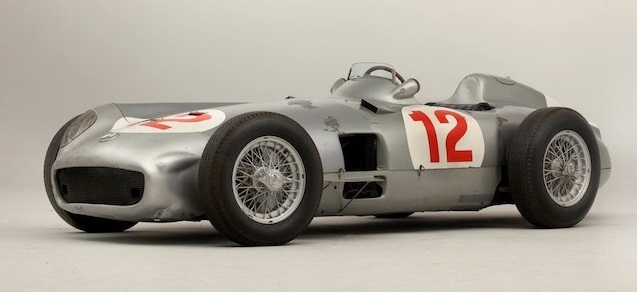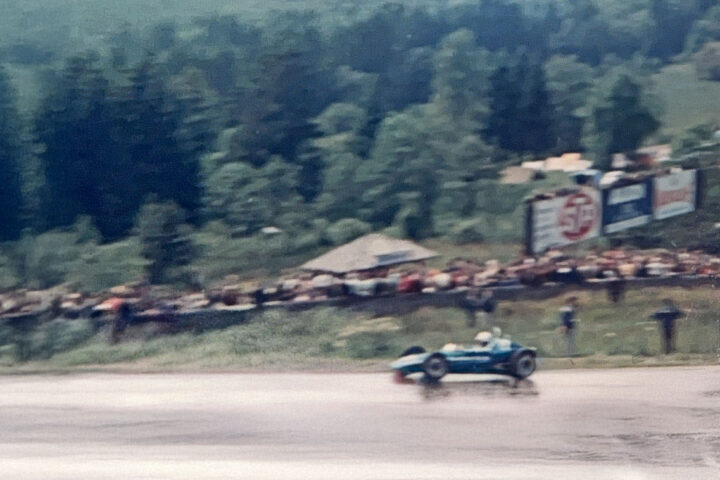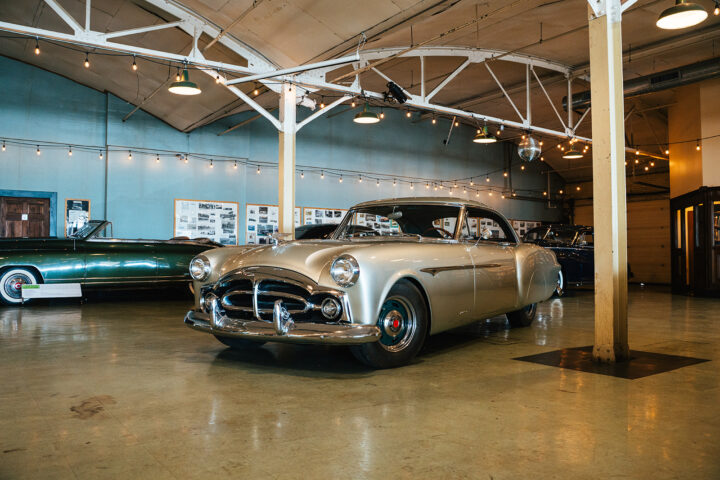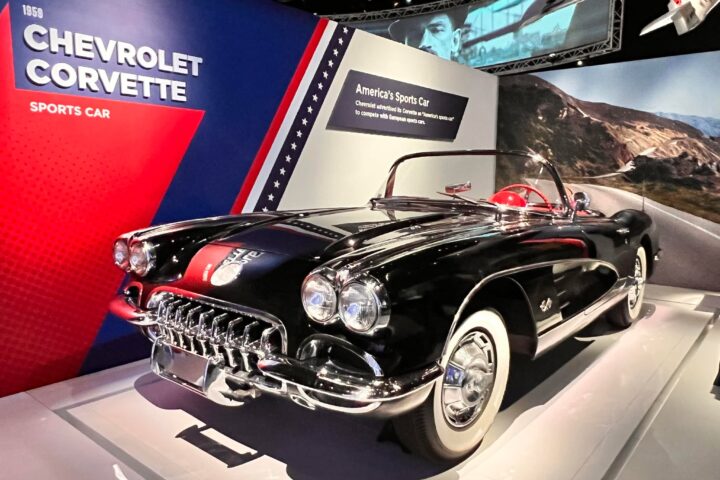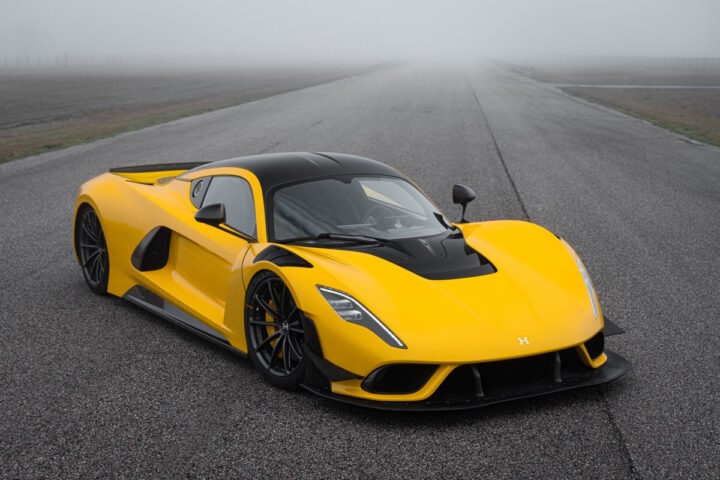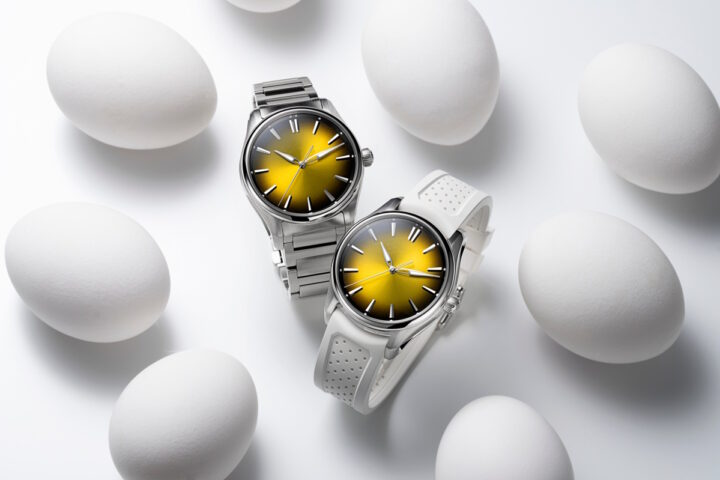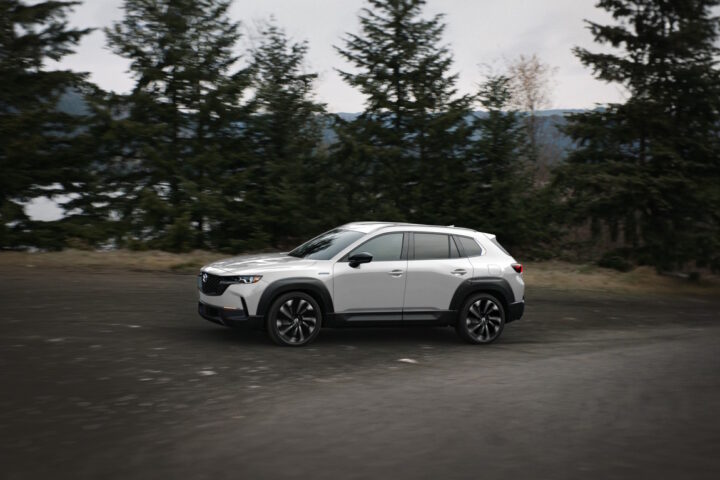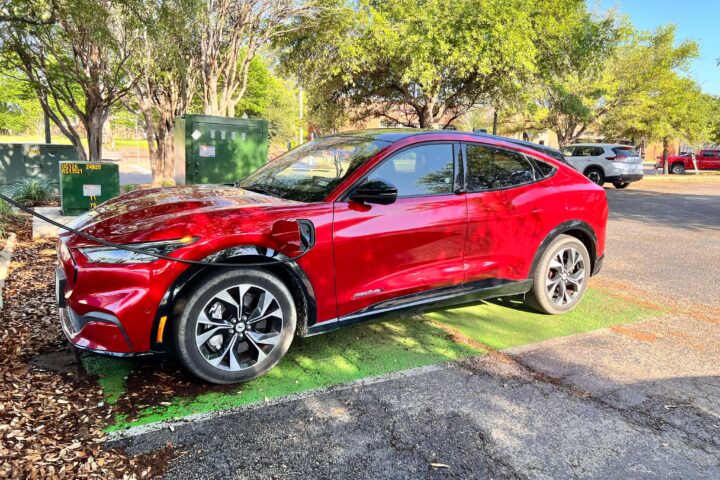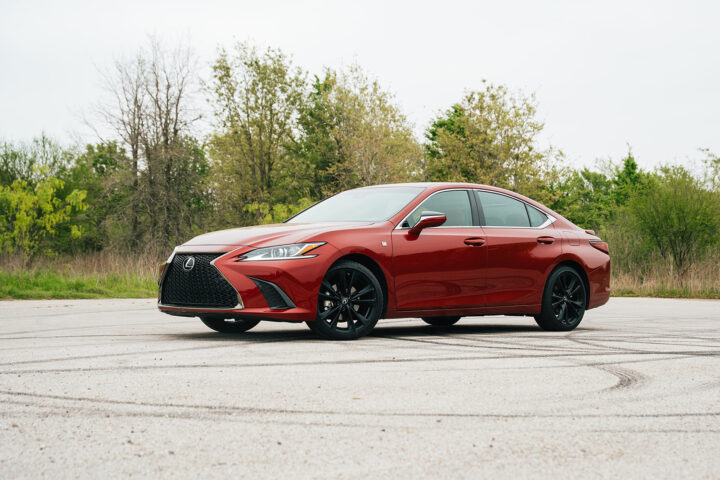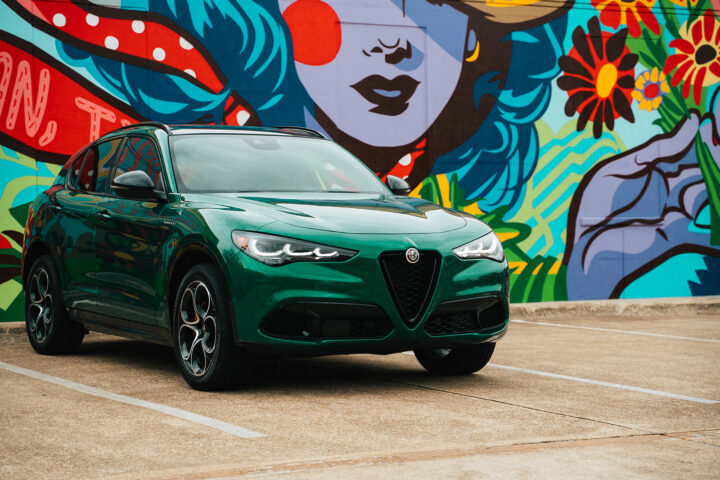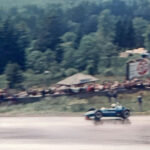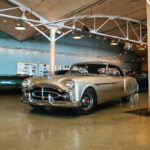The Mercedes-Benz W196R that was piloted by Juan Manuel Fangio in the 1954 German and Swiss Grands Prix, crossed the block at the Goodwood Festival of Speed Bonhams auction for a stunning$29,619,826, setting a new record price for a car at auction. The previous record-holder was a 1957 Ferrari 250 Testa Rossa sold at Pebble Beach in 2011.
The car was driven by a number of notable drivers and is the only W196R that is not in a museum. Check out the images and full auction info below.
Today it is part of postwar German folklore that, on July 4, 1954, at Berne in Switzerland, the underdog German soccer team had just beaten the favorites, Hungary, 3-2 to win the FIFA World Cup. Some claim that this memorably redemptive moment became the first time postwar that the German National anthem had been played at such a major sporting event…
Yet that very same day, at the Reims-Gueux circuit in France, Juan Manuel Fangio had just led home team-mate, Karl Kling, in a brand-new sister Formula 1 Mercedes-Benz W196, to finish first and second in the French Grand Prix.
That shattering success marked Mercedes-Benz’s Grand Prix come-back for the first time since 1939. So July 4, 1954, became a doubly great day for Germany. It might be recalled by most today as having witnessed the footballing ‘Miracle of Berne’ but within the motor racing world, Reims had witnessed something far more predictable. The Italian motor racing axis of Maserati and Ferrari had been trembling in their boots at the prospect of a come-back by what Mr. Ferrari called the ‘TransAlpini and indeed their worst nightmares had been fulfilled. Those near-unbeatable silver cars bearing the three-pointed star were back.
Perhaps it was doubly significant that seven weeks later, after a second come-back victory in the German GP at the Nürburgring, Fangio, and Mercedes-Benz added a third great win, this time in the Swiss GP, which – for the brilliant Argentinian – also clinched his second Formula 1 Drivers’ World Championship title. As he raised his trophy at Berne’s Bremgarten forest circuit he was only a couple of miles away from the Swiss city’s Stadium where elated German soccer captain Fritz Walter had so recently raised the World Cup.
Denis Jenkinson of ‘MotorSport’ magazine set the scene for it all when he wrote: “The name of Mercedes-Benz was one of the most powerful in Grand Prix racing between 1934 and 1939 and during those years they brought a science into motor racing that was revolutionary; at the same time they speeded up the process of racing car design to a pace that forced many of their competitors to abandon Grand Prix racing… With the approach of the new Formula 1 that was due to begin with the 1954 season, Daimler-Benz announced that they would be represented…by an entirely new team of Mercedes-Benz racing cars…”.
When these entirely new streamline-bodied W196 cars emerged at Reims, fans recoiled in astonishment. These sleek new silver rocket ships with their wheel-enclosing bodyshells were futuristically-alien machines from Mars. Drivers Juan Fangio and Karl Kling immediately qualified first and second, then finished 1-2 in this their debut race.
Over the fleeting 14 months that followed completing the 1954 season than on through 1955, the Mercedes-Benz W196 single-seater cars contested 12 World Championship-qualifying Grands Prix. They won nine of them, confirmed Juan Manuel Fangio’s 1954 Drivers’ World Championship, then carried him to a second consecutive Drivers’ title in 1955. With perhaps tacit generosity on Fangio’s part, his team-mates Karl Kling and Stirling Moss won the non-Championship 1954 Berlin GP and the Championship 1955 British GP. Earlier in ’55 Fangio had also won the Formule Libre Buenos Aires City GP.
Through that second season of the W196s’ meteorically brief career, the Daimler-Benz factory team had also campaigned its related 300SLR sports-racing cars. They proved totally unbeatable, winning every Sports Car World Championship race entered except Le Mans from which the team was withdrawn when running 1-2.
Finally, on October 16, 1955, Stirling Moss and Peter Collins won the Targa Florio in Sicily to add the Sports Car title to Fangio’s Formula 1 Drivers’ crown. That night, roly-poly team manager Alfred Neubauer received a letter from Fritz Nallinger, Daimler-Benz AG’s main board Director of Research and Design. Neubauer read: “After mature deliberation, the management committee has decided…to absent itself…irrevocably from motor racing for several years”.
With both World Championships won and total road racing domination re-established, Mercedes-Benz had nothing left to prove…
Thirty-two years later, in September 1987 Doug Nye interviewed Daimler-Benz’s revered former Chief Engineer, 81-year-old Rudi Uhlenhaut, for BBC TV in his old office at Unterturkheim. When asked about his company’s postwar return to serious motor racing in 1954-55, his words were crystal clear.
He said “Believe me…I do not speak propaganda. But when we returned to racing in the mid-1950s, our directive was to be the best and to win both the Formula 1 Drivers’ Championship and the SportsCar Championship. We did that, and – while we could have done better when our board took the decision to withdraw, we were the best”.
That was no idle boast, in fact no boast at all. Rudi Uhlenhaut’s words were simply a statement of fact, and it’s a fact embodied within W196 chassis ‘00006/54’ that we at Bonhams now offer here for sale by auction.
This is the only W196 out of factory or institutional captivity; the only survivor not preserved within either Daimler-Benz or an International museum. Yet it is the most successful of all surviving W196s.
It is the only surviving Mercedes-Benz W196 to have won not just one World Championship-qualifying Grand Prix race, but two. It is the first open-wheel version of the landmark W196 design ever to have won a race, and it is the actual car in which Fangio clinched the second of his five Formula 1 Drivers’ World Championship titles. It is to be offered in remarkably unspoiled, almost ‘barn-find’ condition its super-sophisticated mechanicals believed to be complete and runnable after proper preparation and it is a Grand Prix car in whose presence enthusiasts simply stand and stare…
The car has been inspected in great detail by the factory’s Mercedes-Benz Classic experts, and their report is appended. Save for the paint finish and the replacement of some hoses with modern Aeroquip, the car remains today as last assembled and prepared by the factory Rennabteilung upon the works team’s withdrawal, on December 9, 1955.
For those who understand its stature, and its history and its incredible factory-confirmed as-works assembled specification, Fangio’s 1954 German and Swiss GP-winning ‘Treble-Oh-Oh-Six’ here is absolutely iconic.
Yet there is still more. As a work of supreme mechanical artistry ‘00006/54’s stature surely transcends mere motor racing. This mechanical masterpiece is a work of sculpture entirely emblematic of German industry’s postwar re-emergence from obliteration. Daimler-Benz had emerged from the cataclysm of World War 2 in 1945-47 making bicycles and servicing US Army Jeeps. Mercedes historian Karl Ludvigsen has described how in the late 1940s, anyone who enquired about a possible Mercedes-Benz return to racing would be told: “Please, we are fighting for our very lives. We have no time to think of such things…”.
From July 1948 the ‘European Recovery Program’ better known as the Marshall Plan pumped $13-billion into western-aligned economies. Germany received a share from 1949. Mercedes-Benz car production gathered pace and the board considered an eventual return to racing to promote their brand’s resurgence. An initial racing foray to the Argentine Temporada series in February 1951, using pre-war designed W154 Grand Prix cars, then disappointed.
In April 1951, Mercedes-Benz’s new 300 production car was launched. Its six-cylinder cast-iron engine was adopted to power a new sports-racing car to publicize the marque’s rebound in 1952. The result was the spaceframe-chassised ultra-light W194 300SL ‘Gullwing’ Coupe. These handsome and handy little cars showed the formidable form that year, finishing 2-4 in the Mille Miglia, 1-2-3 at Berne, 1-2 at Le Mans, 1-2-3-4 (in Spyder form) at the Nürburgring, and ultimately first and second in the mighty Mexican Carrera Panamericana.
For that Mexican trip competition manager Neubauer shipped-in the two successful W194 Coupes, two Spyders, two 3½-ton trucks and nearly 40 personnel. To study just one of his team movement sheets is to gaze at a work of art. Every border, every Customs post, even individual Customs officers, were named, telephone numbers provided, hotels and meal-stops booked, rendezvous venues pinpointed, individual journey-stages all given target times. Not only European but also American competitors looked on, and blinked. Mercedes-Benz really had returned.
Through 1953 the factory’s racing efforts concentrated upon development of the all-new 2½-litre unsupercharged Formula 1 cars for 1954. These roller-bearing engined W196 cars broke new ground, successfully introducing to Formula 1 lightweight spaceframe chassis construction, fuel-injected straight-eight ‘laydown’ engines with desmodromic valve actuation, all-round inboard-mounted brakes, and all-independent suspension with low-pivot swing-axles at the rear.
These definingly complex cars emerged late, missing the first two World Championship rounds of 1954 in Argentina and Belgium. Charged with providing his team with every advantage, Neubauer had engaged 1951 World Champion driver Fangio for the Stuttgart team’s re-emergence.
Neubauer had offered him two options either a full race fee to miss early-season GP races for which the new Mercedes would be unready, or to forego that fee and be free to drive for another team. Fangio chose freedom stayed with Maserati and immediately won both of that year’s early GPs in a 250F. Then at Reims that first weekend of July he switched to the three-pointed star…
Decades later, Fangio would recall: “The best team was Mercedes… I never had any worries when I was driving for them because the team was so strong technically. If I asked them to make a change of any kind, they got down to work, and in no time at all, I was back at the wheel with things as I wanted them to be. That’s why I won eight of the 12 races I drove in with them. In another three I was second, third and fourth, and only retired in one at Monaco 1955. In my estimation, 75 percent of the credit for a win went to the car and the group whose work backed it up, and the remaining 25 percent went to the driver, and to luck…”
While the original enveloping-bodied Stromlinienwagen W196s had shone at superfast sun-soaked Reims, they proved a handful around Silverstone in the British GP. It was cold, and the circuit was slick with drizzle. Mercedes’s tire supplier, Continental, had been out of major-league racing for 15 years and the slithering streamliners’ skittishness was due more to inadequate grip than any deficiency in driver view. An alternative open-wheeler slipper-bodied W196 had been planned for the tighter courses, especially for the following German & European GP at the Nurburgring, but the program was still running late.
As Fangio recalled after he’d clouted marker tubs during practice at Silverstone both he and Kling vigorously lobbied Neubauer and engineer Uhlenhaut that night in The Five Arrows Hotel at Waddesdon, near Aylesbury, emphasizing that the promised open-wheeler was not merely preferable for the Nürburgring, but absolutely vital.
In response, three open-wheeler W196s were hastily finalized for Mercedes-Benz’s home race; the Reims-winning Stromlinienwagen chassis ‘00003/54’ stripped and rebodied, plus two sister cars chassis ‘00005’ and ‘00006’ built new as open-wheelers. In the Nürburgring race, Fangio would drive car ‘6, Kling ‘3 and pre-war Champion Hermann Lang (aged 46) car ‘5. Hans Herrmann drove a Stromlinienwagen, car ‘2.
Fangio qualified his brand-new ‘Triple-Oh-Oh-Six’ now offered here on pole position, while Kling lost a wheel on the Tiergarten Straight and had to start way down the grid.
Despite the grief of having lost their compatriot driver Onofre Marimon who had crashed fatally in his works Maserati during practice, Fangio and Froilan Gonzalez of Ferrari promptly ran 1-2 as the Grand Prix began. ‘Triple-Oh-Oh-Six’ outpaced the Ferrari, but was itself caught and passed by team-mate Kling’s W196, charging up from the back of the grid. While Fangio sat back in second place, confident he could handle the German driver/engineer in the closing stages, Kling was a man on a mission before his home crowd. Then he began to taste and smell a fuel haze blowing past him in the cockpit. He realized his car’s tail-tank was leaking, and his apparently crazy pace was to build time to refuel.
Neubauer became frantic. Fangio: “This was not how the race was supposed to run…but I was not responsible, so every time I passed the pits I pointed at Kling as if he had no right to be there…”. Neubauer angrily signaled Kling ‘FANG-LANG-KLING’.
But the veteran Lang could not maintain the pace, eventually to spin off when his W196 seized. With six laps to run the 300,000 crowd eagerly anticipated a home win for Mercedes-Benz and Karl Kling, but the commentator at the Karussel suddenly announced that Fangio had retaken the lead, and Kling was slowing. He stopped at the pits with a transmission mounting broken. It was wired in place and he rejoined to finish fourth.
Having conserved his brand-new car, and ever confident he could have disposed of Kling had he kept running, Fangio hurtled home in ‘Triple-Oh-Oh-Six’ to cement Mercedes-Benz’s comeback with this home-race victory.
Three weeks later, Fangio won the Swiss GP at Berne from his compatriot Gonzalez’s Ferrari and fresh-faced Hans Herrmann, third in his sister W196. Again Fangio’s mount had been ‘Triple-Oh-Oh-Six’ offered here, and as he took the flag in this car so he clinched his second Drivers’ World Championship title.
Thereafter, Hans Herrmann was assigned ‘Triple-Oh-Oh-Six’ as his car for the Italian GP at Monza, in which he finished fourth behind Fangio’s winning Stromlinienwagen chassis ‘00004’. And in the seasons ending Spanish GP at Barcelona, Herrmann retired with spark plug trouble and engine failure, caused by over-rich mixture selected as a precaution invariably hot weather.
Old ‘Triple-Oh-Oh-Six’ was then confined to test duties through 1955 when Stirling Moss joined Fangio and Kling in the full-time factory team. The car was finally recalled to the colors for the season-ending Italian GP at Monza, in which Kling drove her with typical fire and intensity. He ran a strong second behind Fangio’s leading (and eventually winning) Stromlinienwagen chassis ‘2 until ‘Triple-Oh-Oh-Six’s propeller shaft parted, due to the rare omission in the assembly of a locating dowel. Kling was bitterly disappointed, but Mercedes-Benz still dominated Fangio first and guest driver Piero Taruffi second in open-wheeler chassis ’15 the last W196 built.
In fact there had been no chassis ’11, and of the 14 Mercedes-Benz W196 cars built, nine would survive intact until 1991-92 when written-off chassis ‘00005’ would be revived for display in the Daimler-Benz Museum, making ten today. In fact, the factory preserves six W196s cars ‘2-5-8-10-13 and ’14 while ‘3 as an open-wheeler and two Stromlinienwagens, ‘9 and ’12 are in customer-country Museums.
So how did ‘Triple-Oh-Oh-Six’ escape into private hands?
After its final race, driven by Kling at Monza, it had been prepared to full race standard and then consigned to the Daimler-Benz Exhibitions Department on December 22, 1955. In June 1965 it was exhibited in Munich and during 1966 it starred at both Le Mans and Hockenheim. It then appeared at the 1967 British Grand Prix before being used for tire testing at the Unterturkheim factory test-track, and displayed in Berlin and at Stuttgart University. Further display duties followed in 1969 in Luxembourg, Berlin, and Hamburg. A Daimler-Benz Museum archive document records that as of November 5, 1969 “Car should be available at any time for R. Uhlenhaut for testing purposes”.
On June 24, 1972, the car ran in engine tests at Unterturkheim before, on May 22, 1973, Mercedes-Benz officially presented it as a smarter replacement for deteriorating car ’14 to the freshly re-constituted National Motor Museum at Beaulieu, Hampshire, England.
Some years later that Museum’s authorities decided to offer the car for sale, to help finance the construction of a Museum library and lecture-hall complex. Mercedes-Benz supported Beaulieu’s new John Montagu Building and ‘Triple-Oh-Oh-Six’ was sold to Sir Anthony Bamford of JCB Excavators. It was acquired from him in a deal brokered by Adrian Hamilton of Duncan Hamilton Ltd. by French collector Jacques Setton who wanted “simply the World’s most rarefied, most exclusive, Grand Prix car.”
Setton is reputed to have paid what was at the time a world-record price (for any motor car). It then passed subsequently to German businessman Friedhelm Loh who in 1999-2000 ran it in such events as the Monaco Historic Grand Prix, and the Goodwood Festival of Speed, with leading British historic-category driver Willie Green at the wheel. The car was then re-sold and today, after many years out of public view, ‘Triple-Oh-Oh-Six’ is offered here.
This fabulous Formula 1 car’s stature is self-evidently immense. It is not only the iconic ‘Fangio car’ of the 1950s. It is also a shining star of ground-breaking Mercedes-Benz engineering. Amongst Mercedes-Benz cars, it is certainly amongst the top handful in terms of its landmark attributes and achievements.
Here we offer an absolute technological landmark in the long and glittering history of motorsport. And for many perhaps it will be, above all, an emblem of worldwide postwar recovery.
As such this machine is a monument to modern Germany’s resurgence in making friends, not enemies and to human endeavor’s ability to rebound from cataclysm. As such ‘00006/54’, offered here, celebrates World Champion innovation, performance, pace, and the return of peace… It epitomizes everything epitomized by the world-famous Three-Pointed Star.
Please note that the W196 is subject to the reduced import tariff rate of 5% should it remain in the EU.
Executive Summary of the Manufacturer’s Expertise of the Mercedes-Benz W 196 R Racing Car with the Vehicle Identification Number 196 010 00006/54
As an entity of the original manufacturer, Mercedes-Benz Classic has the exclusive competence needed to verify a vehicle’s as-delivered state and to prove this both wholly and without a shadow of a doubt. Accordingly, the Manufacturer’s Expertise of Mercedes-Benz Classic allows us to provide not only recognized vehicle documentation with unrivaled validity but also peace-of-mind to the owners of high-value Mercedes-Benz vehicles.
For the auction of the Mercedes-Benz W, 196 R Formula 1 racing car with the vehicle identification number ‘196 010 00006/54’, the specialists of Mercedes-Benz Classic have also provided such expertise, allowing us to arrive at the following result.
Based on the extensive original documentation in the Mercedes-Benz Classic Archives and an inspection of the vehicle by the Mercedes-Benz Classic specialists, we were able to decisively ascertain that the vehicle in question is, in fact, the original vehicle from the 1954/1955 racing season. The construction, the dimensions and the number of the frame and the body in monoposto open-wheel racing car design and with a wheelbase of 2350 mm corresponds to the vehicle’s as-documented state. The engine fitted in the vehicle, which was able to be identified by means of the identification number stamped on it as well as a number of other markings, was found to be the M 196 R engine model variant with which the vehicle in question retired on 9 December 1955 from a successful racing season. The identification numbers stamped on the front and rear axles, the transmission, and the steering gear clearly indicate that these are components that were also fitted in the vehicle bearing the vehicle identification number 0006/54 at the end of the 1955 season.
The Mercedes-Benz Classic team’s thorough inspection of ‘00006/54’ offered here concluded with their approval stamp being applied to the fabric of the vehicle itself – on chassis, engine, and transmission.
Source: Bonhams

